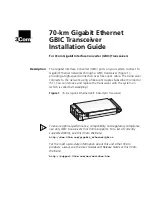
17
Circuit Description
(
2SB1201STP-FA
), Q1040 (
2SC4116GR
), and
D1029 (
02CZ5.6Y
), with temperature compen-
sation provided by thermistors TH1003/TH1004
and capacitors associated with the 14.5 MHz ref-
erence crystal, X1002.
In the receive mode, VCO Q1047 oscillates
between 406.05 and 436.05 MHz, according to the
transceiver version and the programmed receiv-
ing frequency. The VCO output is buffered by
Q1044, and applied to the prescaler section of
Q1049. There the VCO signal is divided by 64 or
65, according to a control signal from the data
latch section of Q1049, before being applied to
the programmable divider section of Q1049. The
data latch section of Q1049 also receives serial
dividing data from the microprocessor, Q1039,
which causes the pre-divided VCO signal to be
further divided in the programmable divider sec-
tion, depending on the desired receive frequen-
cy, so as to produce either a 10 kHz or 12.5 kHz
derivative of the current VCO frequency.
Meanwhile, the reference divider section of
Q1049 divides the 14.5 MHz crystal reference fre-
quency by 1450 (or 1160) to produce the 10 kHz
(or 12.5 kHz) loop reference (respectively). The 10
kHz (or 12.5 kHz) signal from the programmable
divider (derived from the VCO) and that derived
from the reference oscillator are applied to the
phase detector section of Q1049, which produces
a pulsed output with pulse duration depending
on the phase difference between these input sig-
nals. The pulse train is filtered to DC and returned
to varactors D1038 and D1039 (both
1SV276
).
Changes in the level of the DC voltage applied
to the varactors affect the reactance in the tank
circuit of the VCO, changing the oscillating fre-
quency of the VCO according to the phase dif-
ference between the signals derived from the
VCO and the crystal reference oscillator. The
VCO is thus phase-locked to the crystal reference
oscillator. The output of the VCO is then deliv-
ered to the first mixer via buffer amplifier Q1044.
For transmission, the VCO Q1047 oscillates
between 450 and 480 MHz, according to the mod-
el version and the programmed transmit frequen-
cy. The remainder of the PLL circuitry is shared
with the receiver section. However, the dividing
data from the microprocessor is such that the
VCO frequency is at the actual transmitting fre-
quency (rather than being offset by the IF, as in
the receiving case). Also, the VCO is modulated
by the speech audio applied to D1031 (
1SV230
),
as described previously.
Receive and transmit buses select which VCO
is made active via Q1050 (
DTC124EU
). FET
Q1043 (
2SK880GR
) buffers the VCV line for ap-
plication to the tracking bandpass filters in the
receiver front end.
Push-To-Talk (PTT) Transmit Activation
The PTT switch on the microphone is connect-
ed to pin 24 of microprocessor Q1039, so that
when the PTT switch is closed, pin 35 of Q1039
goes low. This signals the microprocessor to ac-
tivate the T
X
/R
X
controller Q1004 (
IMH6
), which
then disables the receiver by interrupting the 9
V supply bus at Q1006 (
DTB123YK
) to the re-
ceiver front-end, FM IF subsystem IC, and receiv-
er VCO circuitry. At the same time, Q1005
(
DTB123YK
) activates the transmit 9 V supply
line to enable the transmitter.
Summary of Contents for VX-2000U
Page 10: ...10 Note Block Diagram ...
Page 11: ...11 Block Diagram VX 2000U Main Unit Block Diagram ...
Page 12: ...12 Block Diagram Note ...
Page 13: ...13 Interconnection Diagram VX 2000U 4ch Front Interconnection Diagram T9206689A Lot 6 ...
Page 14: ...14 Interconnection Diagram VX 2000U 40ch Front Interconnection Diagram T9206689A Lot 6 ...
Page 24: ...24 Note MAIN Unit Lot 1 ...
Page 27: ...27 MAIN Unit Lot 4 Circuit Diagram ...
Page 28: ...28 MAIN Unit Lot 4 Note ...
Page 31: ...31 MAIN Unit Lot 7 Circuit Diagram ...
Page 32: ...32 MAIN Unit Lot 7 Note ...
Page 35: ...35 MAIN Unit Lot 10 Circuit Diagram ...
Page 36: ...36 MAIN Unit Lot 10 Note ...
Page 55: ...Display 1 Unit 55 Circuit Diagram ...
Page 58: ...58 Display 1 Unit Note ...
Page 59: ...Display 2 Unit 59 Circuit Diagram ...
Page 62: ...62 Display 2 Unit Note ...
















































